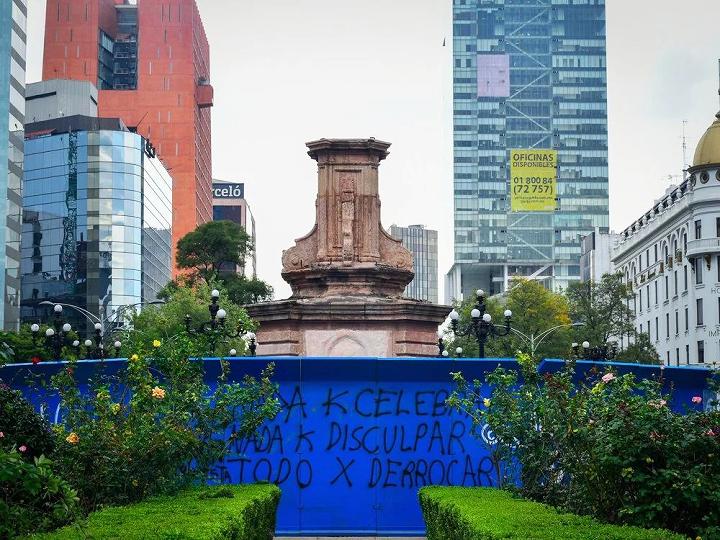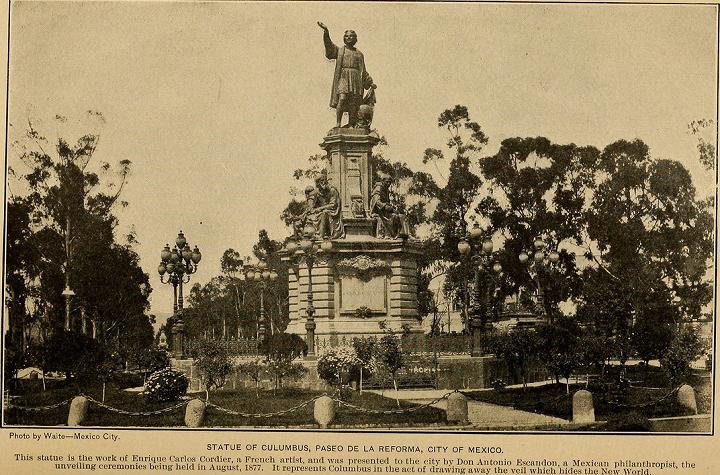 |
Canku Ota
|
 |
|
(Many Paths)
|
||
|
An Online Newsletter
Celebrating Native America
|
||
|
September 2021 - Volume
19 Number 9
|
||
|
|
||
|
Monument To Indigenous
Women Will Replace Columbus Statue In Mexico City
|
||
|
by Nora McGreevy - Daily
Correspondent Smithsonian Magazine
|
||
|
Named after the
Nahuatl word for “water,” the sculpture will depict a
member of the Mesoamerican Olmec civilization
A pedestal in the center of Mexico City that once hosted a statue of Christopher Columbus has stood empty since last October. Now, reports Johnny Diaz for the New York Times, a sculpture of an Indigenous woman is set to replace the controversial explorer’s likeness. Mayor Claudia Sheinbaum announced plans for the new statue last Sunday, on Mexico’s Day of the Indigenous Woman. Designed by Mexican sculptor Pedro Reyes, the soon-to-be installed statue is titled Tlalli—the Nahuatl word for water. It depicts a woman from the Olmec civilization, which inhabited present-day Mexico between roughly 1400 and 400 B.C.E., as Taylor Dafoe writes for Artnet News. The first major civilization in Mexico, the Olmec are best known today for their massive sculptures of human heads. “It is very important to dedicate a monument to Indigenous women and to the earth, because if someone can teach us how to take care of this planet, it is our native peoples and that is precisely what we must learn again,” Reyes tells Mexican newspaper El Universal, per a translation by Artnet News. “We all come from the land and we all return to it, and it is the land that should be in our mind—and not only in the past.” Last October, city authorities pulled the 19th-century Columbus statue from its pedestal in the Paseo de la Reforma, a major street that cuts through the heart of Mexico City. Though officials claimed that the work was removed for restoration, some onlookers suspected that the decision was made in anticipation of protests on Día de la Raza, as Columbus Day is known in Spanish-speaking countries. Protesters routinely defaced the sculpture with spray paint during demonstrations, the Associated Press (AP) reported at the time. Sculpted by French artist Charles Cordier in 1877, the bronze statue depicts Italian explorer Columbus as a conqueror. He stands with one hand raised and the other lifting a veil off of a globe. Columbus’ gesture refers to an outdated history that casts the explorer as the “discoverer” of the Americas. In truth, Columbus ventured to the Caribbean in 1492 and met the Taíno people—one of many civilizations that had been living across North America for tens of thousands of years. The explorer enslaved and killed thousands of Indigenous people; his actions paved the way for European colonization of the Americas and the transatlantic slave trade.
For now, reports the Times, the Columbus statue will be relocated to Parque América, in Mexico City’s wealthy Polanco neighborhood. Last year, as protests against racial injustice swept the globe, protesters toppled Columbus statues around the world in symbolic acts of resistance against racism and colonialism. Activists also targeted statues of enslavers and Confederate monuments. At last week’s press conference, Sheinbaum said that a statue honoring Mexicans’ Indigenous heritage was long overdue. “We’ll place a statue dedicated to the Indigenous woman,” she added, per the Times. “We owe it to them. We exist because of them. It is the history of our country and our homeland.”
Nora McGreevy is a daily correspondent for Smithsonian. She is also a freelance journalist based in Chicago whose work has appeared in Wired, Washingtonian, the Boston Globe, South Bend Tribune, the New York Times and more. She can be reached through her website, noramcgreevy.com. |
||||
|
|
|
|
||
|
|
||
| Canku Ota is a free Newsletter celebrating Native America, its traditions and accomplishments . We do not provide subscriber or visitor names to anyone. Some articles presented in Canku Ota may contain copyright material. We have received appropriate permissions for republishing any articles. Material appearing here is distributed without profit or monetary gain to those who have expressed an interest. This is in accordance with Title 17 U.S.C. Section 107. | ||
|
Canku Ota is a copyright ©
2000 - 2021 of Vicki Williams Barry and Paul Barry.
|
||
 |
 |
|
|
The "Canku
Ota - A Newsletter Celebrating Native America" web site and
its design is the
|
||
|
Copyright ©
1999 - 2021 of Paul C. Barry.
|
||
|
All Rights Reserved.
|
||

